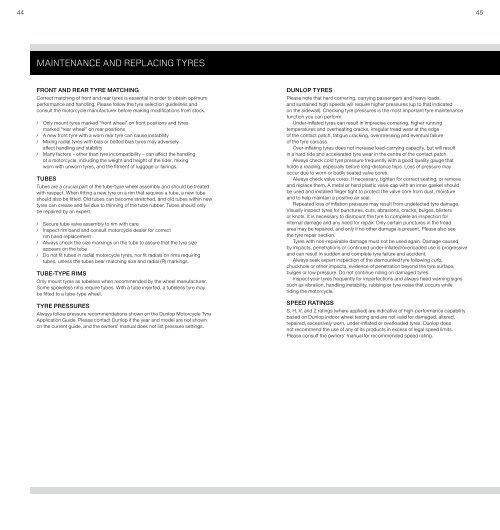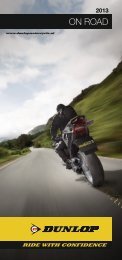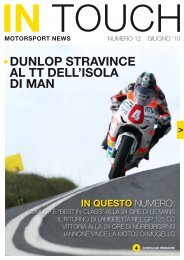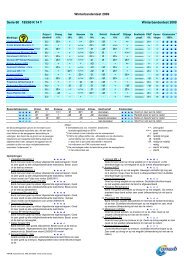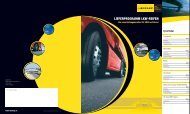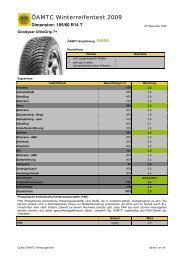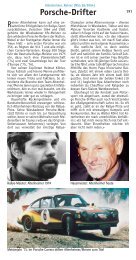2012 - Dunlop
2012 - Dunlop
2012 - Dunlop
Create successful ePaper yourself
Turn your PDF publications into a flip-book with our unique Google optimized e-Paper software.
44 45<br />
MAINTENANCE AND REPLACING TYRES<br />
FRONT AND REAR TYRE mATChINg<br />
Correct matching of front and rear tyres is essential in order to obtain optimum<br />
performance and handling. please follow the tyre selection guidelines and<br />
consult the motorcycle manufacturer before making modifications from stock.<br />
/ only mount tyres marked “front wheel” on front positions and tyres<br />
marked “rear wheel” on rear positions<br />
/ a new front tyre with a worn rear tyre can cause instability<br />
/ mixing radial tyres with bias or belted bias tyres may adversely<br />
affect handling and stability<br />
/ many factors – other than tyre incompatibility – can affect the handling<br />
of a motorcycle, including the weight and height of the rider, mixing<br />
worn with unworn tyres, and the fitment of luggage or fairings.<br />
TUBES<br />
tubes are a crucial part of the tube-type wheel assembly and should be treated<br />
with respect. When fitting a new tyre on a rim that requires a tube, a new tube<br />
should also be fitted. old tubes can become stretched, and old tubes within new<br />
tyres can crease and fail due to thinning of the tube rubber. tubes should only<br />
be repaired by an expert.<br />
/ secure tube valve assembly to rim with care<br />
/ inspect rim band and consult motorcycle dealer for correct<br />
rim band replacement<br />
/ always check the size markings on the tube to assure that the tyre size<br />
appears on the tube<br />
/ do not fit tubes in radial motorcycle tyres, nor fit radials on rims requiring<br />
tubes, unless the tubes bear matching size and radial (r) markings.<br />
TUBE-TYPE RImS<br />
only mount tyres as tubeless when recommended by the wheel manufacturer.<br />
some spokeless rims require tubes. With a tube inserted, a tubeless tyre may<br />
be fitted to a tube-type wheel.<br />
TYRE PRESSURES<br />
always follow pressure recommendations shown on the dunlop motorcycle tyre<br />
application guide. please contact dunlop if the year and model are not shown<br />
on the current guide, and the owners’ manual does not list pressure settings.<br />
DUNLOP TYRES<br />
please note that hard cornering, carrying passengers and heavy loads,<br />
and sustained high speeds will require higher pressures (up to that indicated<br />
on the sidewall). Checking tyre pressures is the most important tyre maintenance<br />
function you can perform.<br />
Under-inflated tyres can result in imprecise cornering, higher running<br />
temperatures and overheating cracks, irregular tread wear at the edge<br />
of the contact patch, fatigue cracking, overstressing and eventual failure<br />
of the tyre carcass.<br />
over-inflating tyres does not increase load-carrying capacity, but will result<br />
in a hard ride and accelerated tyre wear in the centre of the contact patch.<br />
always check cold tyre pressure frequently with a good quality gauge that<br />
holds a reading, especially before long-distance trips. loss of pressure may<br />
occur due to worn or badly seated valve cores.<br />
always check valve cores. if necessary, tighten for correct seating, or remove<br />
and replace them. a metal or hard plastic valve cap with an inner gasket should<br />
be used and installed finger tight to protect the valve core from dust, moisture<br />
and to help maintain a positive air seal.<br />
repeated loss of inflation pressure may result from undetected tyre damage.<br />
Visually inspect tyres for punctures, cuts, abrasions, cracks, bulges, blisters<br />
or knots. it is necessary to dismount the tyre to complete an inspection for<br />
internal damage and any need for repair. only certain punctures in the tread<br />
area may be repaired, and only if no other damage is present. please also see<br />
the tyre repair section.<br />
tyres with non-repairable damage must not be used again. damage caused<br />
by impacts, penetrations or continued under-inflated/overloaded use is progressive<br />
and can result in sudden and complete tyre failure and accident.<br />
always seek expert inspection of the dismounted tyre following curb,<br />
chuckhole or other impacts, evidence of penetration beyond the tyre surface,<br />
bulges or low pressure. do not continue riding on damaged tyres.<br />
inspect your tyres frequently for imperfections and always heed warning signs<br />
such as vibration, handling instability, rubbing or tyre noise that occurs while<br />
riding the motorcycle.<br />
SPEED RATINgS<br />
s, h, V, and Z ratings (where applied) are indicative of high-performance capability<br />
based on dunlop indoor wheel testing and are not valid for damaged, altered,<br />
repaired, excessively worn, under-inflated or overloaded tyres. dunlop does<br />
not recommend the use of any of its products in excess of legal speed limits.<br />
please consult the owners’ manual for recommended speed rating.


